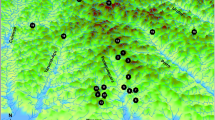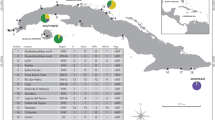Abstract
Aquatic, karst and spring endemic organisms have become a focus of conservation efforts as human population densities and demand for groundwater increase. This is especially true of Texas salamanders in the genus Eurycea that have been the subject of investigations of patterns of genetic differentiation in order to understand their systematics and to inform conservation planning. Here we generated data from several thousand single nucleotide polymorphisms (SNPs) to quantify within- and among-population genetic variation in the northernmost species, Eurycea chisholmensis, the Salado salamander, which is listed as a federally threatened species. We used approximate Bayesian computation and a method based on linkage disequilibrium to estimate effective population size, \(N_{e}\). Levels of differentiation were low, but revealed a primary division between northern and southern populations with no evidence of gene exchange between them. Genetic diversity was similar across all sampling locations and estimates of \(N_{e}\) were largely congruent across the two methods and indicate population sizes large enough to maintain genetic variation, at least over the short term. These results suggest that two management units comprise the range of E. chisholmensis but that further sampling in intervening areas is required to precisely delineate, and determine the nature of, the boundary of these units.




Similar content being viewed by others
Data availability
Genotypic data are available on the Dryad Digital Repository at: https://datadryad.org/stash/share/lw_ECi_Rpm0hbwTPX91iUlKCFEgeTsQHbW1Zd7dyn54.
Code availability
Custom scripts available from the corresponding author.
References
Alberici da Barbiano L, Gompert Z, Aspbury AS, Gabor CR, Nice CC (2013) Population genomics reveals a possible history of backcrossing and recombination in the gynogenetic fish Poecilia formosa. Proc Nat Acad Sci 110(34):13797–13802
Beaumont MA (2008) Joint determination of topology, divergence time and immigration in population trees. In: Matsumura S, Forster P, Renfrew C (eds) Simulations, genetics and human prehistory. McDonald Institute for Archaeological Research, Cambridge, pp 135–154
Beaumont MA, Zhang W, Balding DJ (2002) Approximate Bayesian computation in population genetics. Genetics 162(4):2025–2035
Bendik NF (2017) Demographics, reproduction, growth, and abundance of jollyville plateau salamanders (Eurycea tonkawae). Ecol Evol 7(13):5002–5015
Bell KL, Hamm CA, Shapiro AM, Nice CC (2017) Sympatric, temporally isolated populations of the pine white butterfly, Neophasia menapia, are morphologically and genetically differentiated. PLoS ONE 12(5):e0176989
Bogart JP (1967) Life history and chromosomes of some of the neotenic salamanders of the Edward’s plateau. PhD thesis, University of Texas at Austin
Brooks SB, Gelman A (1998) General methods for monitoring convergence of iterative simulations. J Comput Graph Stat 7:434–455
Chippindale PT, Price AH, Wiens JJ, Hillis DM (2000) Phylogenetic relationships and systematic revision of central Texas Hemidactyliine Plethodontid salamanders. Herpetological Monographs, pp 1–80
Cornuet JM, Pudlo P, Veyssier J, Dehne-Garcia A, Gautier M, Leblois R, Marin JM, Estoup A (2014) Diyabc v2.0: a software to make approximate Bayesian computation inferences about population history using single nucleotide polymorphism, dna sequence and microsatellite data. Bioinformatics 30(8):1187–1189
Csilléry K, Blum MG, Gaggiotti OE, François O (2010) Approximate Bayesian computation (ABC) in practice. Trends Ecol Evol 25(7):410–418
Danecek P, Auton A, Abecasis G, Albers CA, Banks E, DePristo MA, Handsaker RE, Lunter G, Marth GT, Sherry ST et al (2011) The variant call format and VCFtools. Bioinformatics 27(15):2156–2158
Devitt TJ, Wright AM, Cannatella DC, Hillis DM (2019) Species delimitation in endangered groundwater salamanders: implications for aquifer management and biodiversity conservation. Proc Natl Acad Sci 116(7):2624–2633
Diaz P, Warren JB (2019) Salado salamander monitoring final report 2019. Texas Fish and Wildlife Conservation Office, US Fish and Wildlife Service
Diaz P, Montagne MA, Gibson RJ (2015) Salado salamander monitoring final report 2015. Texas Fish and Wildlife Conservation Office, US Fish and Wildlife Service
Driscoe AL, Nice CC, Busbee RW, Hood GR, Egan SP, Ott JR (2019) Host plant associations and geography interact to shape diversification in a specialist insect herbivore. Mol Ecol 28(18):4197–4211
Frankham R (1995) Conservation genetics. Ann Rev Genet 29(1):305–327
Frankham R (2010) Challenges and opportunities of genetic approaches to biological conservation. Biol Conserv 143(9):1919–1927
Fraser DJ, Bernatchez L (2001) Adaptive evolutionary conservation: towards a unified concept for defining conservation units. Mol Ecol 10(12):2741–2752
Fu L, Niu B, Zhu Z, Wu S, Li W (2012) Cd-hit: accelerated for clustering the next-generation sequencing data. Bioinformatics 28(23):3150–3152
Gascon C, Collins JP, Moore RD, Church DR, McKay J, Mendelson III JR (2007) Amphibian conservation action plan: proceedings IUCN/SSC Amphibian Conservation Summit 2005. IUCN
Gelman A, Rubin DB (1992) Inference from iterative simulation using multiple sequences. Stat Sci 7:457–511
Gompert Z, Lucas LK, Buerkle CA, Forister ML, Fordyce JA, Nice CC (2014) Admixture and the organization of genetic diversity in a butterfly species complex revealed through common and rare genetic variants. Mol Ecol 23(18):4555–4573. https://doi.org/10.1111/mec.12811
Gutierrez AM, Guess ST, Pierce BA (2018) Within-spring movement of the Georgetown salamander (Eurycea naufragia). Herpetol Conserv Biol 13(2):383–390
Hare MP, Nunney L, Schwartz MK, Ruzzante DE, Burford M, Waples RS, Ruegg K, Palstra F (2011) Understanding and estimating effective population size for practical application in marine species management. Conserv Biol 25(3):438–449
Hill WG (1981) Estimation of effective population size from data on linkage disequilibrium. Genet Res 38(3):209–216
Hillis DM, Chamberlain DA, Wilcox TP, Chippindale PT (2001) A new species of subterranean blind salamander (Plethodontidae: Hemidactyliini: Eurycea: Typhlomolge) from Austin, Texas, and a systematic revision of central Texas paedomorphic salamanders. Herpetologica pp 266–280
Hudson RR (2002) Generating samples under a Wright-Fisher neutral model of genetic variation. Bioinformatics 18(2):337–338
Hutchins BT (2018) The conservation status of Texas groundwater invertebrates. Biodivers Conserv 27(2):475–501
Jahner JP, Gibson D, Weitzman CL, Blomberg EJ, Sedinger JS, Parchman TL (2016) Fine-scale genetic structure among greater sage-grouse leks in central Nevada. BMC Evol Biol 16(1):1–13
Jorde PE, Ryman N (1995) Temporal allele frequency change and estimation of effective size in populations with overlapping generations. Genetics 139(2):1077–1090
Jorde PE, Ryman N (2007) Unbiased estimator for genetic drift and effective population size. Genetics 177(2):927–935
Kalinowski ST, Waples RS (2002) Relationship of effective to census size in fluctuating populations. Conserv Biol 16(1):129–136
Langmead B, Trapnell C, Pop M, Salzberg SL (2009) Ultrafast and memory-efficient alignment of short DNA sequences to the human genome. Genome Biol 10(3):R25
Li H (2011) A statistical framework for SNP calling, mutation discovery, association mapping and population genetical parameter estimation from sequencing data. Bioinformatics 27(21):2987–2993
Li H, Handsaker B, Wysoker A, Fennell T, Ruan J, Homer N, Marth G, Abecasis G, Durbin R et al (2009) The sequence alignment/map format and samtools. Bioinformatics 25(16):2078–2079
Loáiciga H, Maidment D, Valdes J (2000) Climate-change impacts in a regional karst aquifer, Texas, USA. J Hydrol 227(1–4):173–194
Longley G (1981) The Edwards Aquifer: Earth’s most diverse groundwater ecosystem? Int J Speleol 11(1):12
Lucas L, Gompert Z, Ott J, Nice CC (2009) Geographic and genetic isolation in spring-associated Eurycea salamanders endemic to the Edward’s Plateau region of Texas. Conservation Genetics pp 1309–1319
Lucas LK, Gompert Z, Gibson JR, Bell KL, Buerkle CA, Nice CC (2016) Pervasive gene flow across critical habitat for four narrowly endemic, sympatric taxa. Freshw Biol 61(6):933–946
Lynch M, Ritland K (1999) Estimation of pairwise relatedness with molecular markers. Genetics 152(4):1753–1766
Mandeville EG, Parchman TL, McDonald DB, Buerkle CA (2015) Highly variable reproductive isolation among pairs of Catostomus species. Mol Ecol 24(8):1856–1872
Mills LS (2012) Conservation of wildlife populations: demography, genetics, and management. Wiley, Chichester
Moritz C (1994) Defining ‘evolutionarily significant units’ for conservation. Trends Ecol Evol 9(10):373–375
National Research Council (2015) Review of the Edwards Aquifer habitat conservation plan: report 1. National Academies Press
Nei M (1973) Analysis of gene diversity in subdivided populations. Proc Natl Acad Sci 70(12):3321–3323
Nei M (1987) Molecular evolutionary genetics. Columbia University Press, New York
Oksanen J, Blanchet F, Freindly M, Kindt R, Legendre P, McGlinn D, Minchin P, O’Hara R, Simpson G, Solymos P, Stevens M, Szoecs E, Wagner H (2019) vegan: community ecology package version 2.5-6. https://cran.r-project.org/web/packages/vegan/index.html
Parchman TL, Gompert Z, Mudge J, Schilkey FD, Benkman CW, Buerkle CA (2012) Genome-wide association genetics of an adaptive trait in lodgepole pine. Mol Ecol 21(12):2991–3005
Pew J, Muir PH, Wang J, Frasier TR (2015) related: an R package for analysing pairwise relatedness from codominant molecular markers. Mol Ecol Resour 15(3):557–561
Pierce BA, McEntire KD, Wall AE (2014) Population size, movement, and reproduction of the Georgetown salamander. Eurycea naufragia. Herpetol Conserv Biol 9(1):137–145
Plummer M, Best N, Cowles K, Vines K (2006) CODA: convergence diagnosis and output analysis for MCMC. R News 5(1):7–11
Pritchard JK, Stephens M, Donnelly P (2000) Inference of population structure using multilocus genotype data. Genetics 155:945–959
Puritz JB, Hollenbeck CM, Gold JR (2014) dDocent: a RADseq, variant-calling pipeline designed for population genomics of non-model organisms. PeerJ 2:e431
R Development Core Team (2020) R: a language and environment for statistical computing. R Foundation for Statistical Computing, Vienna
Sotola VA, Ruppel DS, Bonner TH, Nice CC, Martin NH (2019) Asymmetric introgression between fishes in the Red River basin of Texas is associated with variation in water quality. Ecol Evol 9(4):2083–2095
Sunny A, Monroy-Vilchis O, Fajardo V, Aguilera-Reyes U (2014) Genetic diversity and structure of an endemic and critically endangered stream river salamander (Caudata: Ambystoma leorae) in Mexico. Conserv Genet 15(1):49–59
US Fish and Wildlife Service (2000) Policy regarding controlled propagation of species listed under the endangered species act. Federal Register 65(183):56916–56922
US Fish and Wildlife Service (2014) Endangered and threatened wildlife and plants; determination of threatened species status for the Georgetown salamander and Salado salamander throughout their ranges; final rule. Federal Register 79:10236–10293
US Fish and Wildlife Service (2020) Endangered and threatened wildlife and plants; designation of critical habitat for the Georgetown and Salado salamanders. Federal Register 85:57578–57613
Vogler AP, Desalle R (1994) Diagnosing units of conservation management. Conserv Biol 8(2):354–363
Wang J (2005) Estimation of effective population sizes from data on genetic markers. Phil Trans R Soc B 360(1459):1395–1409
Wang J (2007) Triadic IBD coefficients and applications to estimating pairwise relatedness. Genet Res 89(3):135–153
Wang J (2017) Estimating pairwise relatedness in a small sample of individuals. Heredity 119(5):302–313
Wang J, Whitlock MC (2003) Estimating effective population size and migration rates from genetic samples over space and time. Genetics 163(1):429–446
Waples RS (1991) Genetic methods for estimating the effective size of Cetacean populations. Report of the International Whaling Commission (Special Issue) 13:279–300
Waples RS (2006) A bias correction for estimates of effective population size based on linkage disequilibrium at unlinked gene loci. Conserv Genet 7(2):167
Waples RK, Larson WA, Waples RS (2016) Estimating contemporary effective population size in non-model species using linkage disequilibrium across thousands of loci. Heredity 117(4):233
Weir BS (1979) Inferences about linkage disequilibrium. Biometrics pp 235–254
Acknowledgements
We thank C. Mier Y Teran for assistance in the lab, and Ashley Wall and Ryan Jones for assistance in the field. Jim Ott and the Martin/Nice/Ott lab group provided valuable comments and discussion. Three anonymous reviewers and the Associate Editor provided valuable criticism. We also thank Shane Flaherty and the Texas State University LEAP High Performance Computing Cluster. This research was funded by the Clearwater Underground Water District. The views expressed in this paper are the authors’ and do not necessarily reflect the view of the U.S. Fish and Wildlife Service.
Author information
Authors and Affiliations
Contributions
All authors contributed to the study conception and design, material preparation, data collection and analysis. The first draft of the manuscript was written by Chris C. Nice and all authors commented on previous versions of the manuscript. All authors read and approved the final manuscript.
Corresponding author
Ethics declarations
Conflict of interest
The authors declare that they have no conflict of interest.
Funding
Clearwater Underground Water District
Conflicts of interest
None
Ethical approval
Include appropriate approvals or waivers.
Consent to participate:
Not applicable.
Consent for publication
Not applicable.
Supplementary Information
Below is the link to the electronic supplementary material.
Rights and permissions
About this article
Cite this article
Nice, C.C., Fordyce, J.A., Sotola, V.A. et al. Geographic patterns of genomic variation in the threatened Salado salamander, Eurycea chisholmensis. Conserv Genet 22, 811–821 (2021). https://doi.org/10.1007/s10592-021-01364-z
Received:
Accepted:
Published:
Issue Date:
DOI: https://doi.org/10.1007/s10592-021-01364-z




